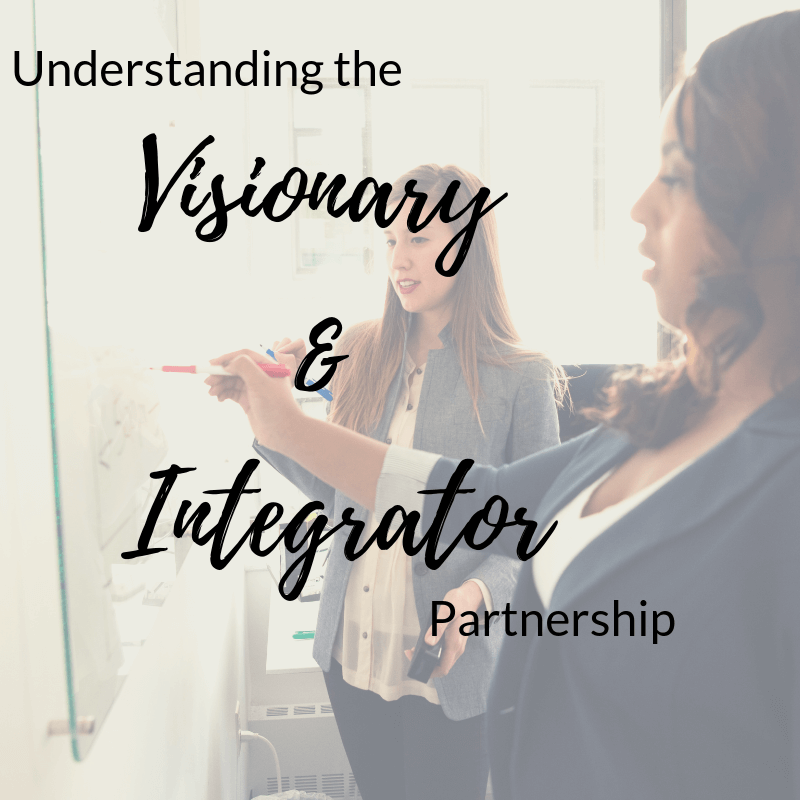Understanding The Visionary & Integrator Partnership
Visionaries love to dream big. They can think up the next big idea, innovate, create, nurture relationships with major clients, are often looking outside of the company to what’s next. They have a large scope for creativity and oftentimes think in the abstract.
Integrators are the do-ers. The ones who pull it all together into a cohesive, streamlined action plan. They can build a strategy plan out the Visionaries coffee napkin notes. They manage communication across an organization and ensure that everyone is aligned. They can work cross-functionally and get super analytical.
One without the other can lead to stagnation, boredom, frustration, and chaos. But the marriage of the two can result in incredible success. You can imagine that at times the two may not see eye-to-eye; thinking so differently, they may disagree on how things should be done. The integrator may need to reel in the visionary at times and the visionary may need to push the integrator out of their comfort zone. So how do the two work in concert? How do they dance instead of box? And if they do dance, who leads?
I’m an integrator and I’ve worked with visionaries my entire career. In my corporate job I had the privilege of working side by side with visionaries who were brilliant and innovative and I would not be running my own successful business if I didn’t have that privilege. The clients I work with today are visionaries across different industries. They’re abstract thinkers who can’t be caged by a system based in a spreadsheet or analytics or metrics, though they know that those are vital to their success.
Here are a few tips to learn the dance of the Visionary / Integrator relationship and to determining who leads:
Communicate & Validate: The visionary and integrator are in a relationship, and just like in all healthy relationships one must listen to the other and understand their needs. What makes them feel heard? How do they need to be validated? An integrator cannot stifle the ideas of the visionary, but they can keep them on track and focused by putting their ideas into a “parking lot” or a repository. Likewise, the visionary cannot commandeer the systems and processes that the integrator has put into place.
Stay in your lane: Integrators can have brilliant, innovative ideas and visionaries can create systems and processes that move the needle. Each should be free to explore these when the moment strikes, but the key to success is in the implementation. Perhaps the visionary hands over the keys of the new tool to the integrator to manage the implementation and cascading throughout the organization. Perhaps the integrator’s big idea gets “handed over” to the visionary to be validated in the marketplace of viability. The key is that they know the other has their best interest (and that of the company) in mind at all times.
Stay the Course: Keep the Vision/ Values/ and Goals as the criteria against which all things are measured. Set your goals, build a strategy around said goals, then create an implementation plan that achieves those goals. If new ideas pop up along the way, GREAT! Move them into the repository and stay focused on what you agreed and aligned upon. Stay. The. Course. If the methodology to achieve your goals isn’t working, adjust, but don’t change entire direction of the ship. Adjust, tweak as needed, and keep going. Measuring against your core criteria will keep things objective and ensure neither person take things personally or build any resentment.
So who leads, then? They both will. They will lead at different times. Maturity, trust, and wisdom dictate who leads when and they both will have their turn at the helm. It’s up to each of them to have the awareness to understand the needs of the company.
* This post was not sponsored, but it is based off of a great book called Rocketfuel by Gino Wickman and Mark Winters. The terms Visionaries and Integrators are terms used in the book, but the ways to manage the partnership (steps 1-3) are mine, though universal, and are based on my experiences.



